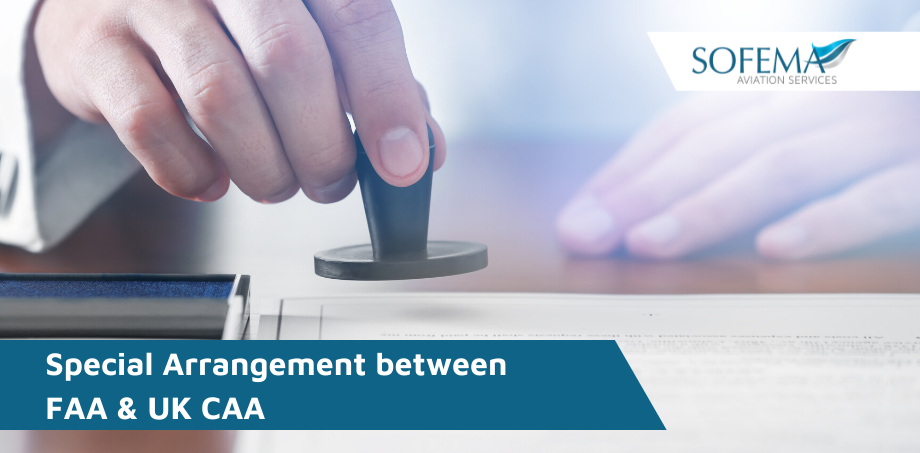Sofema Aviation Services (SAS) www.sassofia.com considers the special arrangement between FAA & UK CAA IPA (Implementation Procedures for Airworthiness) covering Design Approval, Production and Surveillance Activities, Export Airworthiness Approval, Post Design Approval Activities, and Technical Assistance.
Related to the FAA & UK CAA committed, to recognize the work accomplished by EASA before December 31, 2020 – EASA Organisation approvals are to be recognized until December 31, 2022.
This Special Arrangement will terminate on January 1, 2023.
Where EASA has issued the design approval to an entity in the UK, & FAA validation is in progress.
- CAA shall request all documentation associated with the original design approval from EASA or the applicant and
- Notify the FAA that they will take on the responsibilities of the Certificating Authority (CA).
- The FAA and CAA shall recognize all certification/validation decisions made to date and shall maintain any project’s validation plan to the greatest extent possible.
- The FAA shall accept the transfer of validation application to the CAA and UK applicants will not need to re-apply to the FAA for validation; and
- The FAA and the CAA shall follow the validation procedures in Section III of the FAA-CAA IPA for the remaining parts of the project.
Note – EASA has an open application for design approval from an entity in the UK, an FAA validation is in progress and EASA did not complete the validation process before December 31, 2020.
The procedure for continued validation is as follows:
- The CAA shall request all documentation associated with the open application for a design approval from EASA or the applicant and notify the FAA that they will take on the responsibilities of the CA for the project;
- The FAA and the CAA shall recognize all certification/validation decisions made to date and shall maintain the project certification and validation plans to the greatest extent possible;
- The FAA shall accept the transfer of validation application to the CAA and UK applicants will not need to re-apply to the FAA for validation; and
- The FAA and the CAA shall follow the validation procedures in Section III of the FAA-CAA IPA for the remaining parts of the project.
U.S. design approval applicants may choose to rely on the EASA design approval work undertaken by EASA if EASA completes its validation by December 31, 2022. If this is the case:
- The U.S. design approval applicant will make an application to the CAA for validation using the Application for Administrative Validation – form SRG1727.
U.S design approval holders may also elect to separately submit an application for validation to the CAA in accordance with the FAA-CAA IPA (for example, for projects that may extend beyond December 31, 2022).
- If there is a new application, the FAA and the CAA shall follow the validation procedures in Section III of the IPA for the remaining parts of the project. In this case, the applicant may be asked to provide to the CAA all the information they have provided to EASA.
Design Approvals Holders in the UK
In accordance with Annex 8 of the Chicago Convention (Convention for International Civil Aviation), the UK has been, and continues to be, the State of Design for all design approvals by EASA or the CAA to entities in the UK.
However, upon the exit of the UK from the EU, EASA will no longer act as the CAA’s Technical Agent for the purposes of continued airworthiness.
The responsibility for design approvals that were previously issued by EASA to entities in the UK was transferred to the CAA.
The CAA shall make all reasonable efforts to obtain all data associated with the original design approval from EASA and update the FAA on the progress of the transfer of design approvals.
- If the CAA cannot obtain all the data required from EASA, it shall request the data from the applicant. No new certification or validation activities will be required for existing design approvals.
- The CAA shall endeavor to provide the FAA with a list of certificates transferred from EASA to the CAA.
NOTE – Neither the CAA nor the FAA shall reissue the design approvals solely to reflect this transfer of responsibilities.
For all EASA design approvals held by entities in the UK that have been validated by the FAA, the CAA, not EASA, will be considered to be the CA in the context of the IPA.
The FAA and the CAA shall work together to address other unforeseen situations that may arise as a result of the UK’s departure from the European Union.
Next Steps
Follow this link to our Library to find & Download related documents for Free.
Sofema Aviation Services (www.sassofia.com) and Sofema Online (www.sofemaonline.com) provide classroom, webinar & online training – please see the websites for additional information or email team@sassofia.com
Tags:
aviation, CAA, EASA, Airworthiness, FAA, Regulatory Compliance, Certification, SAS blogs, Chicago Convention, Aircraft Design Changes, FAA - CAA IPA, SRG 1727, UK CAA




